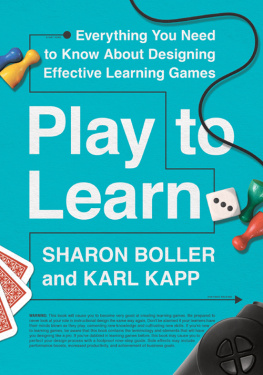Design For How People Learn
Julie Dirksen

DESIGN FOR HOW PEOPLE LEARN
Julie Dirksen
New Riders
1249 Eighth Street
Berkeley, CA 94710
510/524-2178
510/524-2221 (fax)
Find us on the Web at www.newriders.com
To report errors, please send a note to
New Riders is an imprint of Peachpit, a division of Pearson Education
Copyright 2012 by Julie Dirksen
Acquisitions Editor: Wendy Sharp
Project Editor: Susan Rimerman
Developmental Editor: Wendy Katz
Production Editor: Becky Winter
Composition: WolfsonDesign
Indexer: James Minkin
Interior Design: Kathleen Cunningham
Cover Design: Mimi Heft
Illustration Production: Jessica Duff
Notice of Rights
All rights reserved. No part of this book may be reproduced or transmitted in any form by any means, electronic, mechanical, photocopying, recording, or otherwise, without the prior written permission of the publisher. For information on getting permission for reprints and excerpts, contact .
Notice of Liability
The information in this book is distributed on an As Is basis, without warranty. While every precaution has been taken in the preparation of the book, neither the author nor Peachpit shall have any liability to any person or entity with respect to any loss or damage caused or alleged to be caused directly or indirectly by the instructions contained in this book or by the computer software and hardware products described in it.
Trademarks
Many of the designations used by manufacturers and sellers to distinguish their products are claimed as trademarks. Where those designations appear in this book, and Peachpit was aware of a trademark claim, the designations appear as requested by the owner of the trademark. All other product names and services identified throughout this book are used in editorial fashion only and for the benefit of such companies with no intention of infringement of the trademark. No such use, or the use of any trade name, is intended to convey endorsement or other affiliation with this book.
ISBN-13: 978-0-321-76843-8
ISBN10: 0-321-76843-4
9 8 7 6 5 4 3 2 1
Printed and bound in the United States of America
About the Author
Julie Dirksen is an independent consultant and instructional designer with more than 15 years experience creating highly interactive e-learning experiences for clients from Fortune 500 companies and technology startups to grant-funded research initiatives. She has been an adjunct faculty member in the Visualization Department at the Minneapolis College of Art and Design, where she created and taught courses in project management, instructional design, and cognitive psychology. She gets ridiculously excited about things like learning applications of loss aversion or the way glucose is regulated in the brain and shes happiest whenever she gets to learn something new. You can find her online at www.usablelearning.com.
Acknowledgments
There are many, many people Im grateful to, including:
My distributed cognition network, without whom this book would be much worse, including Chris Atherton (book reviewer MVP & person who kept me from saying anything too stupid about brains, although if I did, its not her fault), Dave Ferguson, Janet Laane Effron, Simon Bostock, Rebecca Davis, and Mags Hanley (who kept saying Thats great, Julie, but how do you apply it?).
The Peachpit/New Riders folks, Wendy Sharp, Susan Rimerman, Becky Winter and, most of all, the lovely and patient Wendy Katz.
The people who made it prettyJeremy Beckman, who was unbelievably generous with his time and creativity, Jess Duff, who made everything look better, and Leigh Simmons, who was really patient with me and who, even though I couldnt figure out a way to use it in the book, originated the phrase Ninja cake time! Also, the talented people who created the cover, interior design, and layout for the book.
Michael Allen, who is all you could wish for as a mentor, and Allen Interactions for their sabbatical program (which allowed me to write the original book outline), and for generously letting me use work I did at Allen Interactions (Bicycles!) in this book.
Kathy Sierra, who has been a huge inspiration and very supportive and is more responsible for this book than she probably knows.
All my incredible friends who have listened to me talk about this project for a LONG time, including my own Whuppass GirlsMags (who rates a second mention), Samantha Bailey, and Lori Baker, along with Kathleen Sullivan, Lisa Boyd, Michele McKenzie, Ann Woods, and Lyle Turner. Also, Susan Quakkelaar and Lisa Stortz for their help and ideas, Jodi Hanson for her expert fashion advising, and the lovely and supportive Laura and Alexandra Nedved who are Maxs other family.
All of the smart, interesting people in my professional network, including Tom Kuhlmann, who started me blogging and provided a role model for how to do it, Koreen Olbrish, who introduced me to the learning community on Twitter and who is an all-around rockstar, Will Thalheimer, who has been very generous with his considerable knowledge and advice, Cathy Moore, who I want to be when I grow up, and Jane Bozarth, who was very patient with my questions about all this book stuff. Also the rest of my #lrnchat PLN, the learning technology folks at Harrisburg University of Science and Technology, and the IST program at Indiana University.
All of my colleagues who have provided lots of advice, ideas, and interesting conversations, including Lester Shen, Carla Torgerson, Edmond Manning, Dan Thatcher, Karl Fast, Matt Taylor, the original Studio Z boys, and David Bael (& family).
The people who wrote the books on the inspiration bookshelf: Steve Krug, BJ Fogg, Scott McCloud, Jonathan Haidt, Robin Williams, Ralph Koster, Donald Norman, Stephen Anderson, Jesse Schell, and Kathy Sierra (who also rates a second mention).
The delightful women at the Blue Moon Coffee Shop, where this was largely written.
and
My parents and family, who managed to not freak out and even to be supportive when I said I think Im going to quit my job and freelance so I can work on a book.
Foreword
When working within the artificial intelligence group at Control Data Corporation on advanced learning systems, a colleague questioned why we were using such powerful systems as Cray mega computers for adaptive learning programs and learning simulations. He understood why meteorology and military reconnaissance applications needed them, but why educational systems? Meteorology dealt with vast amounts of data and yet needed to predict future weather quickly. Airborne reconnaissance had to compare visual data from separate flights and perspectives to recognize which objects had moved and which hadnt. But instruction?
Many people surmise yet today that instructional software cant make much computing demand. How hard is it to present and score multiple-choice questions?
I asked my colleague, what causes meteorology and reconnaissance to make heavy computational demands? He replied, the extremely large amounts of data to be gathered and managed, the rapid analysis that was needed, and the need to visualize the results. Hmm. It sounded familiarlike working with human learners. I asked him how much data he thought the human brain might typically contain and what level of complex analysis he thought it capable of. How would it compare to our largest computer? What level of common knowledge and reasoning had we achieved in our intelligent systems? How did that compare to working with people? What level of computation might be required to perform the tasks of a talented teacher and mentor?










